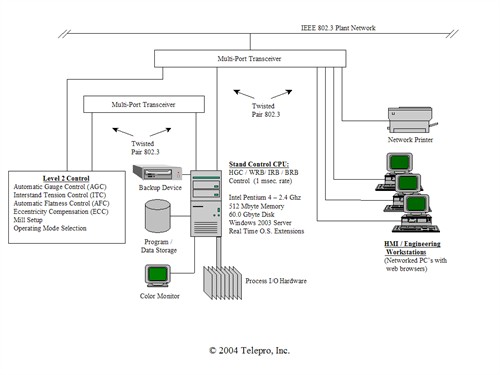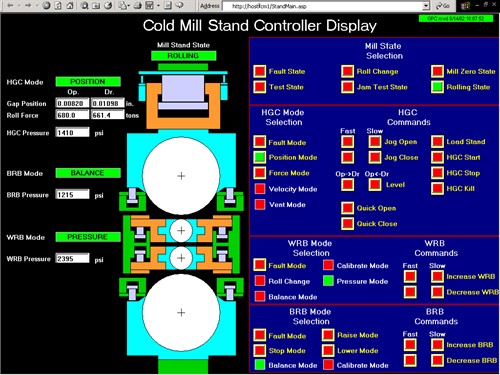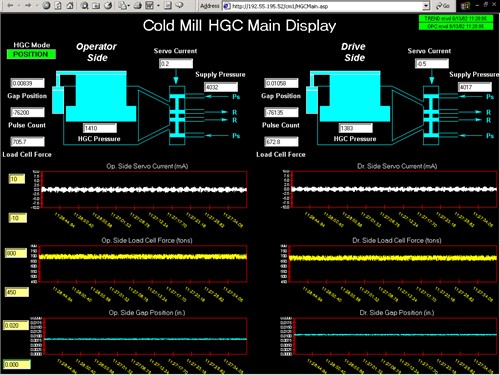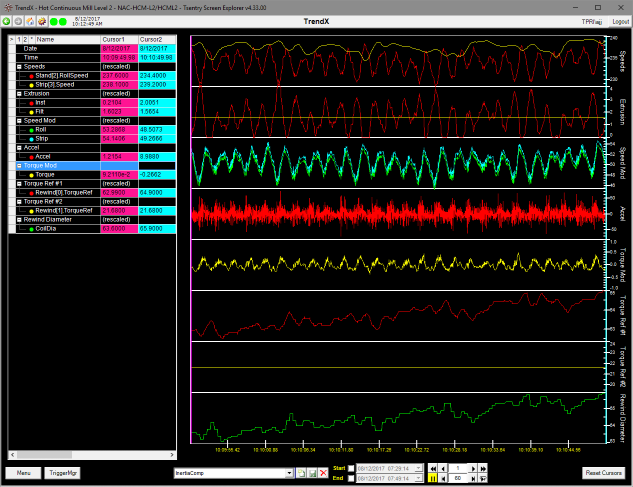Rolling Mill Stand Controller

System Description
The TelePro/SSE hydraulic mill stand controller performs Level 1 device control of the hydraulic cylinders associated with work roll gap positioning, roll bending, and backup roll balancing in rolling mills. A mill stand state machine manages coordination and sequencing of the individual actuator systems, as well as transitions between operating states.
Hydraulic Gap Cylinder (HGC) Control
Hydraulic cylinders for changing the work roll gap are located in either the top or bottom of the mill stand. The HGC control performs closed loop position and pressure regulation of the gap cylinders, depending on the operating mode selected.
HGC Reference Generation
During the mill setup sequence, preset position and roll separating force references are received from an external Level 2 mill setup system or from an operator data entry interface. During rolling, reference modifiers for position and force are received from the Level 2 controls. These modifiers include the average and differential position/force offsets for automatic gauge control (AGC), interstand tension control (ITC), and automatic flatness control (AFC). Operator manual references for average and differential offsets are added at Level 1.
Additional reference position and force offsets are received from an external roll eccentricity compensation (ECC) system. Due to the update speed required for ECC (1 millisecond scan), the ECC reference offsets may be acquired through hardwired analog inputs.
HGC Position and Force Regulation
Independent position or force regulation loops are implemented for the operator and drive side cylinders, depending on HGC operating mode. A supervisory differential position or force loop maintains the desired offset between the operator and drive sides, correcting errors caused by differences in dynamic response between the sides. If excessive differential force is detected, the HGC control is placed in Fault mode and further movement is prohibited. When position regulation mode is active, force regulation is suspended and vice-versa. A bumpless transition mechanism between position and force modes is provided.
Position feedback is provided by Sony Magnescale transducers. Each cylinder is typically fitted with two position transducers, one on the inside and one on the outside of the cylinder, each with separate signal conditioners. If there is no transducer fault, the inside and outside transducer signals are averaged for each cylinder to produce the position feedback value. If one of the transducers is faulted, the other is used alone. If both transducers are faulted, the HGC control is placed in the Fault mode and further movement is prohibited.
HGC Operating Modes
The HGC operating mode is generally selected automatically by the state of the mill stand. The mill operator does not typically select the operating mode. The Fault Mode is entered on intial system startup.
- Position Mode - closed-loop position regulation
- Force Mode - closed-loop force regulation
- Velocity Mode - fixed velocity reference to servos (cylinders retract at fixed rate; used when HGC Stop is selected)
- Vent Mode - full open reference to servo valves (dump all hydraulic pressure)
- Fault Mode - null reference to servo valves (hold cylinders at current position)
Work/Intermediate Roll Bending (WRB/IRB) Control
Hydraulic cylinders acting on the work roll chocks provide positive and negative roll bending. Depending on the mill stand configuration, intermediate rolls with associated bending cylinders acting on their chocks may also be installed. The bending cylinders also provide the roll balancing forces required to maintain a gap between the work rolls when there is no separating force. The WRB/IRB control performs closed loop pressure regulation of the bending cylinders.
WRB/IRB Reference Generation
During the mill setup sequence, preset pressure references for the bending cylinders are received from the Level 2 mill setup system or from an operator data entry interface. During rolling, a reference modifier for each bending system is received from the Level 2 automatic sheet flatness control (AFC). The operator manual reference offsets are added at Level 1.
Fixed roll balancing references are applied when there is no roll force on the stand. There may be several such references, depending on whether the roll stack is being balanced, raised, or lowered. In addition, there is a fixed bending reference applied during the mill gap calibration sequence.
WRB/IRB Pressure Regulation
In pressure regulation mode, a single pressure regulation loop is generally implemented for each roll bending system. However, depending on the mechanical roll stack configuration, independent operator and drive side regulation loops may be implemented.
WRB/IRB Operating Modes
The WRB/IRB operating mode is generally selected automatically by the state of the mill stand. The mill operator does not typically select the operating mode. The Fault Mode is entered on intial system startup.
- Pressure Mode - closed-loop pressure regulation
- (Reference = preset + Level 2 offset + operator offset)
- Calibration Mode - closed-loop pressure regulation
- (Reference = fixed gap calibration reference)
- Automatically entered during the mill gap calibration sequence
- Balance Mode - closed-loop pressure regulation
- (Reference = fixed balance reference)
- Automatically entered when there is no roll force on the stand
- Roll Change Mode - closed-loop pressure regulation
- (Reference = fixed roll change reference)
- Entered when the stand is placed in roll change state
- Fault Mode - null reference to servo valves (hold cylinders at current pressure)
Backup Roll Balancing (BRB) Control
Balancing cylinders act on the backup roll chocks to balance the weight of the rolls and to allow them to be raised or lowered as necessary. The BRB control performs closed loop pressure regulation of the balancing cylinders.
BRB Reference Generation
During the mill setup sequence, a preset pressure reference for the BRB cylinders is received from the Level 2 mill setup system or from an operator data entry interface. No reference modifiers are required.
Additional fixed balancing references are generated at Level 1. These depend on whether the top backup roll is being raised or lowered during roll changing. In addition, there is a fixed balancing reference applied during the mill gap calibration sequence.
BRB Pressure Regulation
In pressure regulation mode, a single pressure regulation loop is implemented for all active cylinders in the backup roll balancing system.
BRB Operating Modes
The BRB operating mode is generally selected automatically by the state of the mill stand. Except for "Raise" and "Lower", the mill operator does not typically select the operating mode. The Fault Mode is entered on initial system startup.
- Balance Mode - closed-loop pressure regulation
- (Reference = balance preset)
- Calibration Mode - closed-loop pressure regulation
- (Reference = fixed gap calibration reference)
- Automatically entered during the mill gap calibration sequence
- Raise Mode - closed-loop pressure regulation
- (Reference = fixed roll raise reference)
- Bottom roll cylinders (if applicable) are vented
- Entered when "Backup Raise" is selected with the stand in roll change state
- Lower Mode - vent all piston side cylinder pressure
- Used to lower the top backup rolls onto the roll changing rig
- Entered when "Backup Lower" is selected with the stand in roll change state
- Stop Mode - vent all piston side cylinder pressure
- Pressurize rod side to retract all cylinders (if applicable)
- Fault Mode - null reference to servo valves (hold cylinders at current pressure)
Mill Stand State Machine
Coordination of the various Level 1 automation systems is performed by a mill stand state machine. A set of specific mill stand operating states and permissible transitions between states is defined. For each of these states, the individual mill stand device controllers have prescribed operating modes and/or sequences.
System coordination consists of selecting the desired mill stand operating state, which in turn triggers the appropriate operating mode selection for each individual system controller. Requests for transitions between mill operating states are received from the operator and from automatic sequences. The latest request for which all permissives are satisfied determines the mill state.
The mill stand operating states consist of the following:
- Fault State
- Entered in response to a strip break, emergency stop request, or other stand fault event. Hydraulic systems are controlled to hold the roll gap position constant until the mill is stopped. When the mill is stopped, HGC pressure is vented.
- Test State
- Hydraulic systems are controlled to known states. Manual references are used for test manipulation of individual systems.
- Roll Change State
- The roll stack is configured to permit installation and removal of rolls.
- Spring Curve Calibration State (Jam Test)
- The relationship between HGC cylinder position and roll separating force is determined by pressing the work rolls together and recording the HGC positions required to reach a series of calibration target forces.
- Gap Calibration State (Mill Zero)
- The HGC position corresponding to the datum gap zero is determined by pressing the work rolls together until a defined roll separating force is reached. The corresponding HGC position encoder pulse counts are stored to capture the datum point.
- Rolling State
- The mill stand is ready for rolling.
System Architecture
The hydraulic mill stand controller is a stand-alone system. The computing platform is the TelePro Tsentry product. It consists of an off-the-shelf Intel Pentium-class PC running the Windows 2003 Server operating system with VenturCom RTX real time extensions. This system comes complete with all facilities required to support deterministic real-time program repetition rates as fast as 1 millisecond.
In addition to performing mill stand control, the system includes both real-time and historical trending. Tsentry also provides a general-purpose real-time computing platform that includes all facilities and libraries required to allow the end user to develop and implement custom process monitoring, control, signal processing, and human-machine interface (HMI) applications. This system interfaces to several varieties of commercially available process I/O hardware and is capable of performing all process control and human-machine interface functions required for mill control. It was developed specifically as a high-speed real-time process control system platform.
The associated HMI displays are implemented as standard Internet web pages hosted by the Tsentry system. The standard Tsentry product includes all facilities required to develop and support a human-machine interface system based on standard web pages. These facilities include custom controls for building animated displays with Microsoft Visual Basic .NET. Automated processes are included for building web screens to execute the controls and for publishing the controls to client workstations. Any network-connected PC workstation with a standard web browser and proper security credentials can be used as an HMI client.
Discrete control devices (pushbuttons, pistol grips, etc.) are provided as needed for machine-side control panels and operator desks located on the production floor.
All hardware employs industry-standard, open-architecture systems commercially available from multiple equipment suppliers. Communication is via industry-standard TCP/IP protocol over ETHERNET. Graphical HMI/Engineering workstation displays are via standard Internet web pages allowing display using standard web browsers and screen building using standard web page development tools.
In a typical configuration, the Tsentry host computer is interfaced to RTP I/O hardware from RTP Corporation via an ETHERNET link available commercially from the I/O equipment manufacturer. Device driver software already in wide commercial use is supplied to manage the data exchange.
A fully-redundant backup CPU can be included in the architecture, but is not required. If the backup CPU is available, switchover from the primary CPU to the backup consists of simply moving network cables and re-assigning network addresses. This switchover can be performed manually in less than 15 minutes.
The automation architecture permits remote technical support through a secure ETHERNET connection. To enable remote support, the customer provides an ETHERNET LAN connection available to a trusted external site and a bridge to isolate the process control computers from the external network.
A typical hardware architecture design is shown in the following diagram:
Figure 1: Level 1 Automation Hardware Architecture

A typical Tsentry host computer is configured as follows:
- 2.4 GHz Intel Pentium 4 CPU, 512 MB memory, CDRW drive
- 60 GByte hard disks
- 2 ETHERNET controllers:
- Backplane: Intel PRO 10/100 for process LAN connection
- 3COM 3C905-TX for control I/O LAN connection
The host system is a standard IBM-compatible personal computer and can be configured according to customer requirements. Though it is not required, this can include mirrored disk configurations, PC server architectures, and alternative PC form factors.
System software includes:
- Windows 2003 Server operating system
- Microsoft Visual Studio .NET software development environment
- VenturCom RTX real-time operating system extensions
- TelePro TSENTRY real-time process control system libraries
- Microsoft Terminal Services
- Symantec PCAnywhere
Prior to commissioning, performance tests are conducted on all systems for extended periods of time to assure reliability.
Graphical HMI/Maintenance Support Displays
The system includes a complete set of operating and maintenance support HMI displays. These include graphical controller monitoring and tuning displays showing controller functional block diagrams with current values of inputs, outputs, internal variables, and activation logic, updated in real time on the screen. These displays, along with the Tsentry real-time/historical data trend facility, provide engineering and maintenance personnel with the necessary information to diagnose the condition of key process control functions. They also permit authorized personnel to modify system tuning and configuration parameters on line.
Operating and maintenance support displays are implemented as standard Internet web pages hosted by the Tsentry system. Any network-connected PC workstation with a standard web browser and proper security credentials can be used as an HMI client. This permits any HMI display to be accessed from any workstation within the production complex.
Displays are developed using a combination of Microsoft Visual Basic .NET and Active Server Pages. Complete facilities for developing and publishing custom HMI displays are provided to the end user.
Examples of the maintenance support displays are shown in Figures 2 and 3. Figure 2 shows the top-level stand controller overview display. Manual mill state and individual controller mode selections, as well as manual setpoint offsets can be made from this screen. Operator inputs are duplicated using discrete control devices at the main operator's desk and at machine-side control panels. Figure 3 shows the main HGC cylinder control monitoring display with critical control variables displayed in both tabular and graphical format.
Figure 2: Stand Controller Overview Display

Figure 3: Main HGC Cylinder Control Monitoring Display

Real-Time/Historical Trend Facility
The Tsentry computing platform provides a real-time/historical data trend facility which supports Internet web page based editing and display of process variables. Data may be displayed and edited from a browser run on the system console or on any network-connected Windows workstation. Both graphical and tabular data displays are provided.
The real-time/historical trend system includes the following functions and features:
- Access by name to any process variable in host global shared memory by means of a data dictionary.
- Data dictionary build process. This process automatically updates the global shared memory data dictionary when new variables are added to the system and old ones are deleted.
- Real-time trend data acquisition. Data is acquired at a 1-millisecond rate (1000 samples per second per point) and made available for display on networked HMI/maintenance support workstations.
- Real-time trend data display. Web page screens are provided for graphical and tabular display of high-speed, real-time data.
- Display pan and zoom features.
- Trend data can be exported as individual Windows files.
- Storage, retrieval, and editing of trend set files, which define graphical and tabular data display configurations: variable names, scaling, display attributes.
- Dynamic trend display editing allows interactive modification of trended variable names, time scales, signal magnitude scales, and text display formats.
- Historical trend display integrated with real-time trend displays.
- Facilities for starting and stopping historical trend data acquisition based on user-defined trigger events.
- Support for multiple variable types: floats, integers, character strings, Booleans.
- Multiple value display formats: float, character, decimal integer, hexadecimal integer, and binary.
- Process variable "Probe" screen. A web page is provided for displaying and modifying any process variable in shared memory by name. The screen is accessible from a web browser run on the system console or on any networked Windows workstation. Data write access can be password protected.
- Process variable "ProbeA" screen. Same functionality as "Probe" for multidimensional array data objects.
- Process variable "TrendX" screen. View up to 24 simultaneous signal trends in real time on up to six independent Y axes.
Examples of the Probe and TrendX screens are shown in the Figures 4 and 5.
Figure 4: Process Variable "Probe" Screen

Figure 7: Process Variable "TRENDX" Screen

Conclusion
This system consists of standard TelePro/SSE rolling process control technology tailored to the specific needs of each customer. The use of proven automation products improves system reliability and reduces the time required for engineering, development, installation and commissioning. These standard products are customized for each application in the areas of: system sequencing, operator interface requirements, maintenance and diagnostic support tools, and mill-specific equipment interfaces. The use of standard, open-architecture system components allows for configuration flexibility and eliminates special-purpose hardware/software.
TelePro/SSE mill automation systems are designed, developed, commissioned and supported by engineers with extensive process control experience on all types of rolling mills. We have spent many years working directly with plant technical and operating personnel to understand the functional requirements for these systems. Our process understanding and system integration expertise make us uniquely qualified to deliver the highest levels of performance and reliability across a wide range of product and process conditions.
